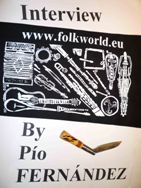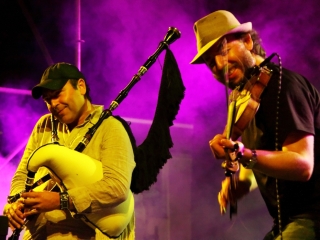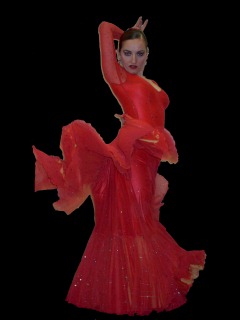
Just by chance, while doing my 2012 Christmas shopping in Madrid, I run into a top Irish violinist and musicologist who has become fairly visible in the folk music scene in Europe. He plays with artists such as the Galician gaita pipers Carlos Núñez and Anxo Lorenzo and in the Irish-Portuguese-Galician trio Assembly Point. While playing the violin in the show Riverdance, he met the flamenco soloist Rebeca Mateos-Morante, and since 2009 he lives with her and their daughter in Spain. In this interview, Eoghan NEFF tells us a lot about his career and latest music projects.
P. FERNÁNDEZ: Around 2010, I remember seeing you a couple of times in Madrid’s Irish pub ‘La Taberna de Elisa’ [a 1990s stronghold for live folk music, ... now facing a misty future since early 2013]. You were performing with a local uilleann and Asturian bagpiper (César Pastor) in the band Duo Nua. I was always curious about your background.
Eoghan NEFF: I come from Rathpeacon, what could only be described as a cluster of fields, country houses and cottages with a pub and a national primary school. It is nestled between Blarney and Cork City. In a typically Irish setting, traditional music was all around me, and played by my family. I began with two sticks, imitating the fiddle. Soon after, my parents replaced those sticks with a real instrument.
So, on which instruments did you focus your musical education, and who were your key masters?
I don’t play anything else other than the fiddle. If ever a musician played something that would make me want to take up a different instrument, I would just try to replicate that using the fiddle instead. I took my first fiddle lessons from a local fiddler, Gary Cronin, for two years, more or less. I also attended summer schools for a good number of years thereafter. I was fortunate that Cork had, and continues to have, an extremely healthy fiddling community, largely stemming from the renowned Sliabh Luachra tradition. It was easy pickings for a kid fiddler trying to gather a variety of ways of making noise.
Was your learning mostly on traditional Irish music, or was it also oriented to classical music, for example?
Until university, any kind of contact with genres of music outside of my direct immersion inside Irish traditional was either fleeting (perhaps a television commercial featuring a pop song); limited (for instance the specific Western art pieces included on the secondary school listening curriculum); or diluted (these outside influences as heard among fellow Irish traditional musicians). As such, my musical learning was exclusively focussed on traditional Irish music. I’m aware that it surprises many that my early exposure to music was so “small town”. However, it is probably as a consequence of my exclusivity to Irish traditional music that I developed the idiosyncrasies heard in my playing. From early on, I explored the subconsciously muted, or “superfluous”, sounds and noises that come out of traditional instrumental practice. I subsequently refined, or stylised these to expand my own musical resources.
Regarding your career on traditional Irish music, can you recognize the main influence/style from a specific area in Ireland (Co.Cork, South, West or East of Ireland,...)?
The idea of regional styles never interested me. I always thought the goal was to achieve a personal style.
Who were your musical ‘idols’ and influenced you the most on your early days?
Tommy Peoples has always been a paragon of fiddle playing for me, and naturally my greatest musical influence. I was lucky that the late Séamus Creagh used to play sessions locally in Cork, and certainly he influenced my slow air playing in particular. I remain a huge fan of Tommy Potts, as well as many of the Donegal fiddlers belonging to the generation of John Doherty. Concerning bands, The Bothy Band has always remained a firm favourite.
When did you decide to become a professional fiddler?
My professional and academic careers have always gone hand in glove. During my undergraduate years I performed throughout Ireland, Europe, and the United States with my brother, Flaithrí, who is an exceptional uilleann piper. We released a couple of CDs as NeffBros. After graduation, we were both involved with Riverdance and toured with the show for a number of years. During my postgraduate and doctoral studies I returned to the professional stage as a soloist and with a variety of other bands and recording projects.

In which bands have you played in Ireland, the UK or other places since then?
I have toured and/or recorded with many projects since NeffBros and Riverdance. Some highlights include the Anxo Lorenzo Band, The London Metropolitan Orchestra, Assembly Point, Amalgamare, Torc, etc. I first met Anxo, a virtuoso of the Galician gaita, in Armagh while making some field recordings for the Irish Traditional Music Archive. Later, Anxo invited me to guest on his first album and we have been touring constantly ever since. We have a second album coming out very shortly. I have another especially exciting project under development that fuses Irish and Icelandic folk elements under the umbrella of cinematic electronica. Its members are two sets of siblings, myself (fiddle) and Flaithri Neff (Uilleann pipes/whistles) from Ireland; Atli Örvarsson (keyboards) and Þórhildur Örvarsdóttir (vocal) from Iceland; as well as the Canadian percussionist Satnam Ramgotra.
Tell us about your studies on musicology. Have they influenced your career as a musician and composer?
My active involvement with both a broad professional music industry and an advanced academic research field is interdependent. Whether using free improvisation to gain a philosophical understanding of musical individualism, or advancing an ergonomic-based theory of 20th century avant-garde Irish fiddle practices, etc. Always, my research-informed idiosyncratic performance practices together with my applied performative research methodologies are conditioned, essentially, by one another.
The work that you have been doing as a musician and composer until today, was it mostly on traditional Irish music or was it also on other types of music?
As an Irish fiddle-player I seek out creative music projects while trying not to appease genre borders. Obviously, since entering the professional music world I’ve done a lot of generic Irish music and music from the other so-called Celtic regions. Yet I have fused with other folk, jazz, classical, pop, rock, and improvisation genres too.
Tell us a bit about your work on music for films: How did it happen? Is it based on Irish trad music or other styles as well?
Well, it’s not Irish trad really. Only sometimes it involves re-composing and arranging Irish tunes. A lot more of the time it is just producing soundscapes, or improvising melodies out of the stimuli provided by the composer or the moving images themselves. Film composers are very appreciative of my idiosyncratic sounds because their compositional pallet is widened all of a sudden. They also value my ability to improvise, freely or in tandem with whatever they’ve prepared. I entered the cinema world via a Kevin Macdonald movie, The Eagle, scored by the hugely talented Atli Örvarsson. It was a fantastic way to begin, with such a renowned, Oscar-winning, and yet down to earth director. Thankfully, it is an unfinished journey, because the new Irish/Icelandic project I spoke about previously has come out of this.
In which places have you played and lived along your career?
I have toured too many countries to list here! I have been all over really, mainly in Europe. But I have lived only in Ireland, Wales, and Spain.

How and when did you arrive to Spain and decided to settle in Madrid?
My wife, Rebeca Mateos-Morante, is from Madrid. We met in Riverdance where she was touring as the flamenco soloist. We were coming back and forth to Madrid for a long time before we eventually settled here in January 2009, together with our lovely daughter Nóra.
I remember you playing in Spanish folk bands such as: Carlos Núñez’s, Finis Terrae, Duo Nua, Anxo Lorenzo’s, Assembly Point, .... How is so far your folk music experience in Spain?
Funnily enough, I toured very little in Spain before moving over here. Yes, Carlos Núñez invited me to join him on stage when we met in Madrid, and we repeated that in Cork afterwards too. I do still perform locally with folk musicians in Madrid also, the trio NASC being the most active at the moment (Giselle Lau – voice, E. Neff - fiddle, Hamish Binns – guitar). Realistically, though, my professional music career is more internationally focussed rather than locally focussed.
How does it work to do Irish folk music, but in a place so far from its country of origin? Do you also keep involved in the Irish traditional music scene?
It doesn’t matter where I am. It’s not like I have to stay in Ireland to be an Irish fiddler, that can’t change now, it’s who I am. From a professional perspective, many of my projects have members scattered around the planet in such places as Galicia’s Moaña, Cork, Akureyri (Iceland) and Los Angeles. It works fine today, thanks to the available technology. And yes, I’m still very much part of the Irish traditional music scene. For instance, one Irish-based group I perform with, Deep End of the Ford, will begin a new improvisational composition for the Derry City of Culture this summer. Again, international travel and communication makes everything so convenient today.

Tell us about your latest CD, ‘Week One’. Why such title?
Well, it is quite a mysterious art-box CD. It is built around the idea of a case file, concerning my musical activities. Why someone or some collective would be keeping tabs on me is open to conjecture. I wouldn’t want to ruin the experience by explaining my version of it. The title works on many levels, the most superficial being a reference to the case file period.
Do you find a way to define the music in ‘Week One’: Trad Irish, progressive folk music, experimental, ...?
I’m sure others will define it. All I can say is that as an Irish fiddler, my interests lie in progressive ergonomics, free improvisation, and the avant-garde.
What kind of instruments and recording techniques have you used?
I have used one acoustic fiddle, the only instrument I own. Sometimes I prepare the fiddle using a variety of materials such as loose bow-hairs, my own wedding ring, or the traditional mute, etc. From my bridge pick-up, I run the fiddle through a looper, which is a “Boomerang III” model. Basically, this looper plays back exactly what you play in; or it can play that back to you at half-speed or in reverse. It is an old-school concept I suppose, yet done extremely well. It is exactly what I need, because I prefer to avoid any effects units in favour of a deep exploration of the acoustic possibilities of the instrument. It is all recorded 100% live in a small dark underground storage room. There are no pre-recorded loops, no electronic effects, and absolutely no post-editing. Any other way just feels like cheating to me! Live looping permits me to produce in parallel what before I could only produce linearly. It has proved an ideal tool for my performance goals.
What do you want to transmit to the audience?
I want it to be an experience. I would like to think that the whole project is consumed by the audience in its entirety. It is a case file, made true also by the way in which I recorded the music and lived the process. Being a hand-crafted art-box CD, I hope it reaches people at a very personal level also. Obviously the music remains the priority, and it is for each listener to decide ultimately what that transmits.
What can you tell us about songs such as: ‘Nórá’, ‘Hag’, ‘Barrel’, ‘Krafter, with a kiss’, ...?
Nóra is a new composition of mine, a polka. As I was arranging it, my daughter began dancing her fingers upon a glass table. I asked if she liked the tune, and she assured me that she did. I thought it was a lovely moment where she embodied both my own and her mother’s artistic identities; that of instrumentalist and dancer respectively. For that reason, the tune bears her name and her influence. All other tracks have a traditional impetus. Usually, I recompose substantially the traditional tunes that I add to my repertoire. Admittedly, a direct association with a traditional counterpart is occasionally difficult to make out. That’s just a case of musical priorities. All in all, I am content that this is an extremely varied CD which belies the minimal instrumentation used. Certainly, I don’t like to repeat myself, so I use a broad mix of sonorities and tempos; from rapid distortions to slow breath-like sounds.
How can we purchase your CD ‘Week One’?
It can be purchased at my concerts, or directly from my website. As I’m still not a fan of the MP3 culture, it can only be purchased in its unique, original format. Being an art-box CD makes it especially necessary to maintain the physicality of my project, I believe. The reaction to this has been extremely positive. People seem to appreciate the opportunity of giving a physical gift of music to their loved ones once more.
What other recordings can we find today reflecting your past and present work?
OK, to serve as a select chronological and varied overview, I would recommend Each Other’s Shadow by NeffBros; Amalgamare: Improvisations from Glenstal Abbey by pipe organist Cyprian Love and myself; Assembly Point by the trio of the same name fusing Irish, Galician and Portuguese influences; The Eagle soundtrack I spoke of before; and the forthcoming Anxo Lorenzo album.
What instruments do you play today? Who are their makers?
My violin is well over a hundred years old, and its maker unknown.
What other styles of music and artists do you listen to and even play sometimes, besides traditional Irish?
Although my taste in music now comprises many genres, my attention is always on the avant-garde or experimental facets of any genre. I have a lot of avant-garde jazz, experimental and minimalist Western art, and virtuosic exploratory traditional music in my personal CD collection.
On which other projects/bands are you engaged now, and which are your plans in 2013?
My primary focus in 2013 is on my solo work, promoting the new album with Anxo Lorenzo, developing the new Irish/Icelandic project, and working on some academic publications.
Can you give us a tip for those folk music fans visiting Ireland and looking for some of its most interesting trad music?
Come to Cork!!
Photo Credits:
(1) Eoghan Neff,
(2)-(3) Anxo Lorenzo,
(4) Rebeca Mateos-Morante (unknown/from websites).